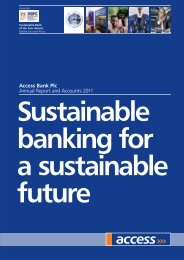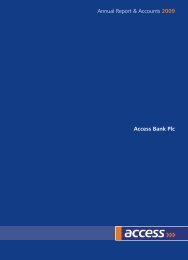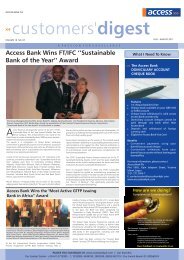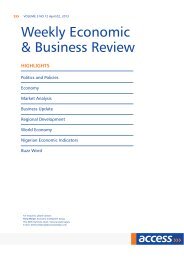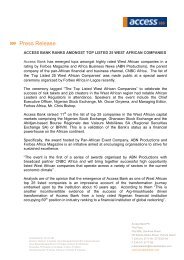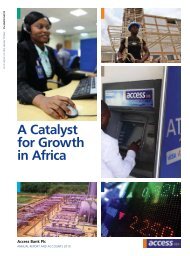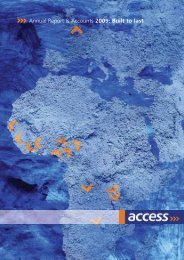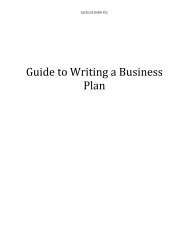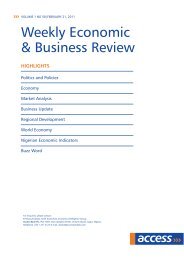2008 Financial Statement - Access Bank
2008 Financial Statement - Access Bank
2008 Financial Statement - Access Bank
Create successful ePaper yourself
Turn your PDF publications into a flip-book with our unique Google optimized e-Paper software.
<strong>Access</strong> <strong>Bank</strong> Plc and Subsidiary Companies<br />
Group <strong>Financial</strong> <strong>Statement</strong>s – 31 March <strong>2008</strong><br />
Together with Directors’ and Auditor’s Reports<br />
Operational Risk Managment<br />
Operational risk is the risk of loss resulting from inadequate or failed internal processes, people, or<br />
systems, or from external events. Our definition of operational risk excludes regulatory risks, strategic<br />
risks and potential losses related solely to judgments with regard to taking credit, market, interest rate,<br />
liquidity, or insurance risks. Major sources of operational risk include: operational processes,<br />
information technology challenges, outsourcing activities, service providers, strategic framework,<br />
mergers and acquisitions, fraud and forgery, regulatory compliance, social and environmental factors.<br />
The <strong>Bank</strong>s operational risk strategy seeks to minimize the impact that operational risk can have on<br />
shareholders value. The <strong>Bank</strong>s strategy is to:<br />
- reduce the likelihood of occurrence of expected events and related cost by managing the risk<br />
factors and implementing loss prevention or reduction techniques to reduce variation to earnings;<br />
- minimize the impact of unexpected and catastrophic events and related costs through risk<br />
financing strategies that will support the <strong>Bank</strong>s long term growth, cash flow management and<br />
balance sheet protection; and<br />
- eliminate bureaucracy, improve productivity, reduce capital requirements and improve overall<br />
performance through the institution of well designed and implemented internal controls.<br />
In order to create and promote a culture that emphasizes effective operational management and<br />
adherence to operating controls, there are three distinct levels of operational risk governance structure<br />
in <strong>Access</strong> <strong>Bank</strong> Plc.<br />
Level 1 refers to the oversight function carried out by the Board of Directors, Board Risk Committee<br />
and the Executive Management. Responsibilities at this level include ensuring effective management of<br />
operational risk and adherence to the approved operational risk policies.<br />
Level 2 refers to the management function carried out by Operational Risk Management Group. It has<br />
direct responsibility for formulating and implementing the <strong>Bank</strong>s operational risk management<br />
framework including methodologies, policies and procedures approved by the Board.<br />
Level 3 refers to the operational function carried out by all Business Units and Support Functions in the<br />
<strong>Bank</strong>. These units/functions are fully responsible and accountable for the management of operational<br />
risk in their units. They work in liaison with operational risk management to define and review controls<br />
to mitigate identified risks.<br />
Internal audit provides independent assessment and evaluation of the <strong>Bank</strong>s Operational Risk<br />
Management Framework. This periodic confirmation of the existence and utilization of controls in<br />
compliance with approved policies and procedures, provide assurance as to the effectiveness of the<br />
<strong>Bank</strong>s Operational Risk Management Framework.<br />
7



